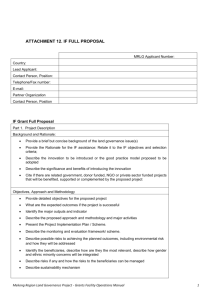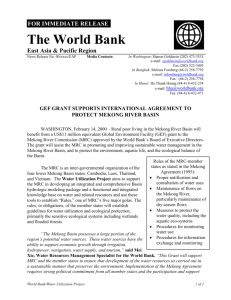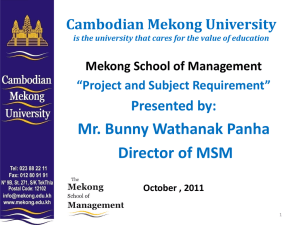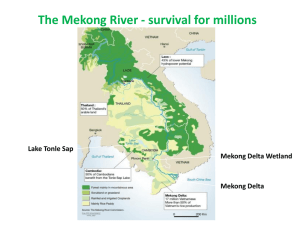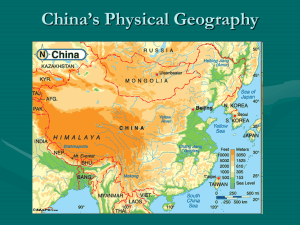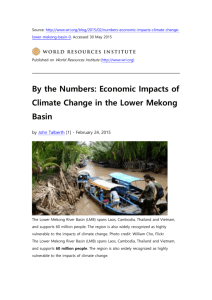Project Descriptions
advertisement
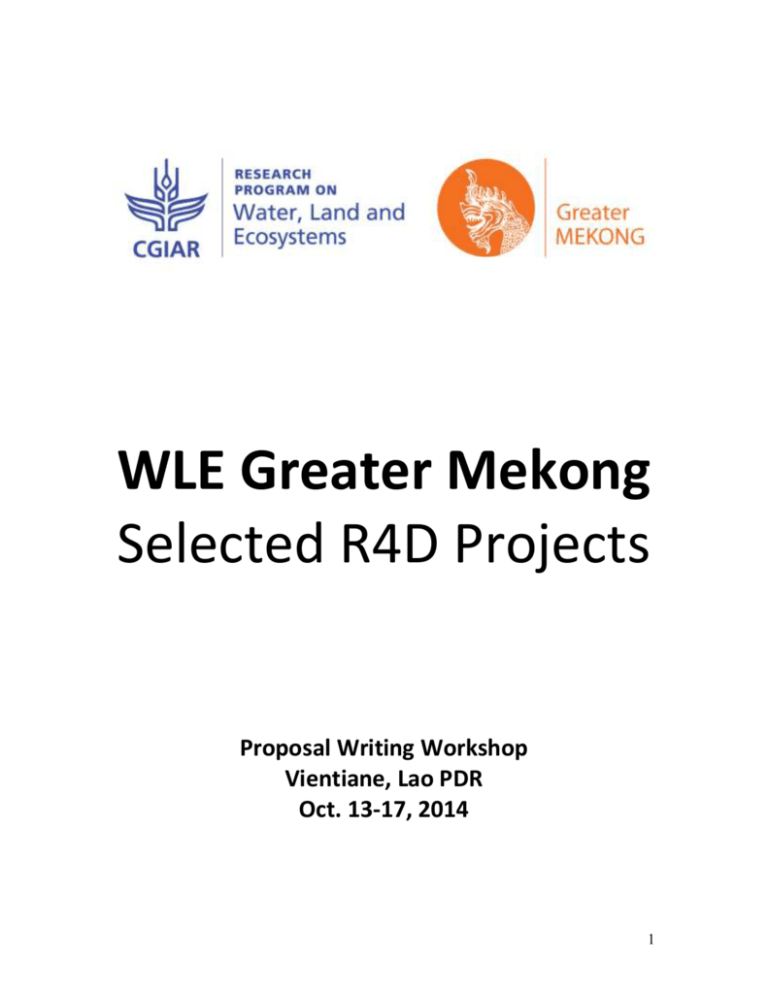
WLE Greater Mekong Selected R4D Projects Proposal Writing Workshop Vientiane, Lao PDR Oct. 13-17, 2014 1 Projects 1 Topic A 2 Topic A 3 Topic B 4 Topic B 5 Topic B 6 Topic B 7 Topic C 8 Topic D 9 Topic D 1 0 Topic D 1 1 Topic E 1 2 Topic E 1 3 Topic E 1 4 Topic E Mekong: Space for Dialogue: People, Perceptions and Principled Outcomes in the Greater Mekong led by the Cambodia Development Resource Institute. Salween: Matching policies, institutions and practices of water governance in the Salween-Thanlwin-Nu River Basin: Towards inclusive, informed, and accountable water governance led by the Department of Geography, Ryerson University (Canada). Mekong: Developing an operational framework for river health assessment in the Mekong River Basin led by Water Engineering and Management, AIT (Thailand). Mekong: Balancing River Health and Hydropower Requirements in Lancang River Basin led by Ecofish Research Ltd (Canada) Salween: Rivers for life and livelihoods: classification of river health in the Greater Mekong subregion – Salween river, led by the International Water Management Institute (International) Irrawaddy: Rivers for life and livelihoods: classification of river health in the Greater Mekong subregion – Ayeyarwady River Basin led by International Center for Environmental Management (Australia). Mekong: River food systems from villagers’ perspectives in the Mekong Delta, led by WARECOD (Viet Nam). Mekong: Implementing cross sectoral negotiations to coordinate Nam Xong livelihoods, ecosystem services and agricultural intensification led by the Mekong Region Futures Institute (Thailand and Laos). Irrawaddy: A Landscape Approach to the Upper Ayeyarwady River Basin: Building Inclusive Governance Processes to Address Resource Conflicts led by the Water Security Research Centre, School of International Development, University of East Anglia (UK). Red: Inclusive development paths for healthy Red River landscapes based on ecosystem services, lby Delft University of Technology (Netherlands). Mekong: Professional Development of Water Governance and Regional Development Practitioners in the Mekong Basin led by Mekong Sub-region Social Research Centre, Faculty of Liberal Arts, Ubon Ratchathani University (Thailand). Salween: Professional Development of Water Governance and Regional Development Practitioners in the Salween Basin led by the Masters on International Development Studies (MAIDS), Faculty of Political Science, Chulalongkorn University. Irrawaddy: Capacity building and professional development to contribute to improved water governance, management, and monitoring of the Irrawaddy river basin led by UNESCO-IHE (Netherlands). Red: Capacity Building and Professional Development of Water Governance and Regional Development Practitioners in the Red Basin led by the Institute for Water and Environment, Vietnam Academy for Water Resources, Ministry of Agriculture and Rural Development (Viet Nam) Project Leaders Kim Sean Somatra somatra@cdri.org.kh Vanessa Lamb vlamb@ryerson.ca Babel Mukand msbabel@ait.asia Yu Xuezhong xzyu@ecofishresearch.com Matthew McCartney m.mccartney@cgiar.org Jeremy Carew-Reid jecr@icem.com.au Nga Dao nga@warecod.org.vn Alex Smajgl alex.smajgl@mekongfutures.com Oliver Springate-Baginski Oliver.springate@uea.ac.uk Nick van de Giesen n.c.vandegiesen@tudelft.nl Kanokwan Manorom kmanorom11@gmail.com Carl Middleton Carl.Chulalongkorn@gmail.com Wim Douven w.douven@unesco-ihe.org Nguyen Tung Phong phongicd@gmail.com 2 Topic A Mekong Title Space for Dialogue: People, Perceptions and Principled Outcomes in the Greater Mekong Led By Cambodia Development Resource Institute Project Leader and Contact Info Kim Sean Somatra - somatra@cdri.org.kh Partner Organizations National University of Singapore Department of Peace and Development, Goteborg University NGOFORUM, Cambodia Water Resources Management Research Center, Rajamangala University of Technology Isan (RMUTI) Project Summary We focus squarely on research for development, where the question is no longer whether to develop, but how. Indeed, it is now widely agreed the objective of water governance is to achieve the triple bottom line of development, equity, and sustainability. This project builds on this insight – too often, the how of development has been prescribed by external international agencies, scholarship and financing institutions. This project argues that there should be spaces for dialogue – to allow for more room for locally-determined notions of governance, fairness and equity to feature into the rules of the game. This has a special resonance for Mekong water governance. Among the rivers in the Greater Mekong region, the Mekong has the most intense development of hydropower and economic activity. This complicated competition over water resources and the hydro-political interplay of global, regional, and local powers makes a negotiated approach to governance critical. The dominant narrative today is that Upper Reaches hold little accountability to downstream countries, leading to trans-boundary conflict. But unequal distribution of development gains exists within countries also, and marginalized communities often suffer due to development efforts, facing threats of restricted livelihood, environmental damage, cultural loss, and eviction. Undoubtedly, development goals may conflict (e.g., industrialization and electrification versus secure rights and livelihoods), as do interests of communities, the private sector, and governments, all leading to a potential collision course if water governance shortfalls go unresolved. Our Mekong Water Governance (MWG) project will systematically study and provide a governance map of the Mekong River Basin at local, state, and international levels; construct a locally responsive, community-informed definition of good governance; assess the current state of governance according to emergent standards; and explore ways to expand and improve upon the space for dialogue and inclusiveness and accountability of governance processes. Our aims are: to construct an indigenous, cross-sector definition of good governance; to develop a Mekong governance map, which analyzes the political economy drivers; to assess the current state of Mekong governance in relation to the definition of “good governance” and a view of water as an important resource and vital human need. 3 Salween Title Matching policies, institutions and practices of water governance in the Salween-Thanlwin-Nu River Basin: Towards inclusive, informed, and accountable water governance Led By Department of Geography, Ryerson University (Canada) Project Leader and Contact Info Vanessa Lamb - vlamb@ryerson.ca Partner Organizations MA in International Development Studies (MAIDS), Chulalongkorn University, Thailand Regional Centre for Sustainable Development (RCSD), Chiang Mai University, Thailand Karen Environment and Social Action Network (KESAN) Paung Ku, Myanmar Renewable Energy Association Myanmar (REAM) Myanmar Academic Research Society (MARS) Green Watershed IWMI This research links to a wider array of potential partners involved in the SalweenThanlwin-Nu (STN) Studies Group recently established (http://salweenstudies.wordpress.com/) Project Summary Shared between China, Myanmar and Thailand, the Salween-Thanlwin-NuRiver (referred to as Salween River in this proposal) supports the livelihoods and food needs for more than six million people. Rapid political transformations in Myanmar at the national level and the ethnic states that lie within the basin are redistributing power and access to resources, and have implications for the river basin’s development trajectory. Ongoing economic integration between Myanmar, Thailand and China – and more broadly in the Greater Mekong Subregion and ASEAN – is also shaping the river basin’s future. The basin is the target of more than 20 large dam projects as well as large-scale agricultural investment and increasingly the focus of international aid. These projects have been planned without comprehensive basin-wide assessment to date on ecosystem, local livelihoods and local systems of governance. Despite the Salween River’s importance, limited water governance research has been undertaken to capture the different cultural, political, and socio-economic values generated by the Salween River and its adjacent basin ecosystems. A key knowledge gap regards the political and economic drivers that (re)shapes the basin’s development trajectory, including linkages to land, energy, and environmental issues, and how they are shaped by gender and ethnicity. The proposed project will be the first initiative to assess and understand the political economy of the Salween as a trans-boundary river basin, and map out the economic and political drivers and rationales that (in)directly shape water governance structure, processes, and outcomes across scales. The project will explicitly address linkages between local and higher scales of water governance through multi-scaled research (local, sub-national, national, regional). The focus is on water, related resources (land and agriculture, energy production), and environment. The project will also support capacity building of the research partners, build local researcher and university networks across the Salween basin, engage in dialogues and forums, and culminate in a major public conference. 4 Topic B Mekong Title Developing an operational framework for river health assessment in the Mekong River Basin Led By Water Engineering and Management, AIT (Thailand). Project Leader and Contact Info Babel Mukand - msbabel@ait.asia Partner Organizations Pollution Control Department (PCD), Thailand Thai Water Partnership (TWP) Project Summary The Mekong River is arguably the most important river in South East Asia, which has been the focus of a number of research studies given the rich biodiversity, and large population, it supports. Over the years, increasing unplanned development pressures within the basin have caused many direct threats to important ecosystems and endangered species for which the region is renowned. The aquatic resources of the Mekong River and its tributaries are essential for supporting the livelihoods of a large percentage of the basin population (almost 67 million), and the sustainable management of these resources depends on maintaining the health of the river. River health assessments are not a new concept, and a number of such assessments have been carried out worldwide: e.g. Freshwater Health Assessment (2014: For Canadian rivers), River Health and Environmental Flow in China Project (2012: for selected Chinese rivers), Framework for Assessment of River and Wetland Health (2011: for South west Western Australian Rivers), National Rivers and Streams Assessment (2009: for US rivers). In a broader (macro) context, WEM (lead partner for this EOI) was also involved with a similar project in collaboration with UNEP to evaluate the freshwater vulnerability in selected international rivers in Asia, which included the Mekong (http://www.unep.org/dewa/Assessments/Ecosystems/Water/tabid/6954/Default.aspx). At a regional level, The Mekong River Commission (MRC) has also monitored the ecological health of the river between 2003 and 2008. While the premise of river health assessments has not changed much with time, with improved knowledge and understanding of the riverine ecosystem, the methods of doing so, in particular the choice of river health indicators, have evolved rapidly. River health indicators (and corresponding health assessments) have traditionally been centered on ecological issues (single perspective, ecological function-based, water quality and macroinvertebrate indices, etc.) and it is only recently that other points-of-view such as catchment disturbance, hydrological changes, effects on human health, riparian habitat conditions, etc. are being taken into consideration. However, gaps still remain. Although the community’s role in river health has been repeatedly highlighted, hitherto social indicators on community satisfaction are not used. Similarly, climate change implications on river health have been relatively unexplored. The proposed project will develop a river health assessment framework for rivers in the Greater Mekong, which will encompass a range of objectives from vision to action. 5 Mekong Title Balancing River Health and Hydropower Requirements in Lancang River Basin Led By Ecofish Research Ltd (Canada) Project Leader and Contact Info Yu Xuezhong - xzyu@ecofishresearch.com Partner Organizations Asian International Rivers Center (AIRC), Yunnan University, China Faculty of Agriculture (FOA), National University of Laos Project Summary Hydropower plays a vital role in meeting the energy and climate goals of China and Lancang River is one of the 13 hydroelectric bases of China. Hydropower projects bring renewable source of energy and storage capacity for flood control and drought resistance, but also have the potential to create complex impacts on river ecosystem, which is the primary driving force of river health in Lancang River Basin. Facing the conflict between ecological and economical demands, decision makers and stakeholders must strike a balance between hydropower and river ecosystem needs. Appropriate methods for assessment, monitoring and management of the project’s effects on river ecosystem will be helpful to maintain or rehabilitate river health at a certain level. The assessment of hydroelectric projects’ impacts on river ecosystem, trans-boundary ecological effects and the state of river health should be thoroughly studied in Lancang River Basin according to changes of projects scheme and climate conditions in recent years. Of equal importance is the study and advancing of the environmental management mechanism of hydropower projects in operation stages in this region, which will continuously improve effectiveness of mitigation and compensation activities and state of river health. The proposed project will develop and promote scientific and management approaches to balance both river health and hydropower needs in Lancang River Basin. The concept of river health in this project incorporates both ecological and human values: a healthy river ecosystem is sustainable and resilient to stress, maintaining its ecological structure and function over time similar to the natural (undisturbed) ecosystems of the region, with the ability to recover from disturbance, while continuing to meet social needs and expectations (Meyer 1997, Karr 1999, Stantec 2005, Bunn et al. 2010). A Multi-scale Impact and State Assessment method (MISA) will be developed and applied to evaluate the projects’ effects on river ecosystem as well as the state of river health. The indicators of river health assessment may be grouped into four categories: physical (hydrology, connectivity, river morphology, and landscape), water quality (physical, chemical, and Nutrients), biological (fish community, benthic macro-invertebrates, and riverine vegetation) and human value (flood, drought, navigation, and water consumption). The ecological effects and trans-boundary effects of hydropower projects and state of river health in Lancang River Basin will be evaluated with the application of the MISA. 6 Salween Title Rivers for life and livelihoods: classification of river health in the Greater Mekong subregion Led By International Water Management Institute (International) Project Leader and Contact Info Matthew McCartney - m.mccartney@cgiar.org Partner Organizations Myanmar Institute for Integrated Development (MIID) Myanmar Ecosystem Conservation and Community Development Initiative (ECCDI) Myanmar Ministry of Environmental Conservation and Forestry (MOECAF) Myanmar Directorate of Water Resources and Improvement of River Systems (MOT) International Centre for Environmental Management (ICEM) Project Summary The research conducted in this project will contribute in a tangible way to Myanmars proposed Water Framework Directive and achieving the goal of Myanmar’s draft integrated water resources management policy, namely “…to develop, share and manage the water resources of Myanmar in an integrated, holistic and socially inclusive manner, to contribute significantly to the poverty alleviation, to the green growth and sustainable development of the nation…” By contributing to the objectives of the broader consortium it will also contribute directly to the mandate of the Mekong River Commission, “to promote and coordinate sustainable management and development of water and related resources for the countries’ mutual benefit and the people’s wellbeing”. The project is underpinned by our hypothesis that the sustainable use and development of a river system for all river users, especially for improved livelihoods of riparian communities, is based upon maintaining a healthy river ecosystem. We will establish an assessment and classification system to determine the health status and potential of rivers as measured by the condition of specific biological, hydromorphological, physical and chemical elements. The visions and needs for a healthy river system will be compiled from the different river user groups – water supply for industry and domestic use, waste water treatment and disposal, irrigation, hydropower, navigation, tourism, fishermen, and riparian farmers. We envisage a RHF based on the principle of acceptable levels of change working at multiple scales. Basin scale assessments of current water resources utilisation and catchment disturbance will be derived through remote sensing. This will be complimented by work with riparian communities located along designated reaches, to establish river health baselines, indicators and pilot monitoring programs that reflect local concerns and priorities. This citizen science component will enable local people (ethnic groups, women and men) to contribute to the RHF by identifying key issues of concern to them, participating in the monitoring of their own rivers and making a preliminary evaluation of the health of water bodies in their community. The selection of indicators, at the different scales, will be guided by their relevance to important environmental/livelihood assets and values, and their likely response to different drivers of change. Selected indicators will respond to stressors/threats in a predictable way and reflect the range of ecosystem health values of interest. We will develop assessment tools (e.g. for monitoring) and guidance for the classification system that, although consistent in the method of application, will allow for different types of aquatic system and take into account the broad diversity of ecological regions in the basin/GMS. 7 Irrawaddy Title Rivers for life and livelihoods: classification of river health in the Greater Mekong subregion Led By International Center for Environmental Management (Australia) Project Leader and Contact Info Jeremy Carew-Reid - jecr@icem.com.au Partner Organizations Myanmar Ministry of Environmental Conservation and Forestry (MOECAF) Myanmar Directorate of Water Resources and Improvement of River Systems Myanmar Institute for Integrated Development (MIID) Myanmar Ecosystem Conservation and Community Development Initiative (ECCDI) International Water Management Institute (IWMI) International Water Centre Project Summary This project will contribute directly to Myanmar’s proposed Water Framework Directive and to achieving the goal of Myanmar’s draft integrated water resources management policy “…to develop, share and manage the water resources of Myanmar in an integrated, holistic and socially inclusive manner, to contribute significantly to the poverty alleviation, to the green growth and sustainable development of the nation…”. As part of the consortium’s broader activities it will contribute directly to the MRC’s mandate, “to promote and coordinate sustainable management and development of water and related resources for the countries’ mutual benefit and the people’s wellbeing” and its ongoing work on river monitoring. The project is underpinned by our hypothesis that the sustainable use and development of a river system for all users, especially for improved livelihoods of riparian communities, is based on maintaining healthy river ecosystems. We will establish an assessment and classification system to determine the health status and potential of rivers and linked aquatic ecosystems as measured by the condition of specific biological, hydro-morphological, physical and chemical elements. We envisage a system based around the principle of acceptable levels of change working at multiple scales (see section 18 diagram). Basin-scale assessments of current water resources utilisation and catchment disturbance will be derived through remote sensing, and future scenarios for development. The visions and needs for a healthy river system will be compiled from the different river user groups – water supply for industry and domestic use, waste water treatment and disposal, irrigation, hydropower, navigation, tourism, fishermen, and riparian land owners and cultivators. This will be complimented by work with communities in designated sub-catchments, to establish river health baselines, indicators and pilot monitoring programs that reflect local concerns and priorities. This citizen science component will enable local people (including ethnic groups e.g. Shan and Kachin, women and men) to contribute to the classification system by identifying key issues of concern to them, participating in the monitoring of their own rivers and making a preliminary evaluation of the health of water bodies in their area. 8 Topic C Mekong Title River food systems from villagers’ perspectives in the Mekong Delta Led By WARECOD (Viet Nam) Project Leader and Contact Info Nga Dao - nga@warecod.org.vn Partner Organizations People Committees Division of Education Department of Natural Resources and Environment (at each province) Women Union Departments of Environment and Agriculture under An Giang and Can Tho Universities VTV6 (a formal Vietnamese TV channel on environmental education Project Summary The Mekong Delta with its three distinct geographical areas (flooding, middle alluvial and saline coastal areas) plays very important role in ensuring food security in Vietnam. While rice is dominant in the delta as a whole, each area is well known for certain types of products, like fishery in the flooding area, fruits in the middle alluvial area and shrimp in the coastal area. In general, the Mekong Delta provides fifty percentage of country’s paddy rice and fifty five percentages of national fisheries and fruit crops. It is home to and provides food and nutrition to more than 20 million people living there. However, recently, communities in the delta are suffering dual impacts from both climate change and unsustainable river/water use such as hydropower dam building, river overexploitation, which made local people more vulnerable and limited their livelihood and nutrition sources. Moreover, in some areas of the Mekong delta, the government built dykes to prevent flood so villagers can cultivate all year round, which degrades the soil and adversely impacts on aquatic habitats in the delta. Since 2012, WARECOD has provided technical support to local people in conducting local research knowledge (Thaibaan research) in 3 communities in the flooding area of An Giang and Dong Thap provinces. One important outcome of the research was that villagers gained the confidence to participate in dialogues with authorities and were willing to share ideas with other communities. After the Thaibaan, the volunteer researcher groups have been transferred into river monitoring groups for self-managing water and aquatic resources in their areas. Based on the successful results of the previous projects we are planning to expand our work to six communities in the other two geographical areas of the delta. We expect at least two out of six research groups to consist only of women in order to get more perspectives from women in the delta. We will continue our work with communities both inside and outside the dykes to see differences between practices of local people in different sides of dyke geography. This project will contribute to better understanding of communities’ dependence on the river for food in different geographical regions of the Mekong Delta. It will help document villagers’ experiences with changes that arise from dams/dykes development and other threats in food production, and raise the voices of grass-root communities in the delta. An exchange visit to Laos will be organized in the third year of the project to share knowledge and concerns with Laotian local research groups. 9 Topic D Mekong Title Implementing cross sectoral negotiations to coordinate Nam Xong livelihoods, ecosystem services and agricultural intensification Led By Mekong Region Futures Institute (Thailand and Laos) Project Leader and Contact Info Alex Smajgl - alex.smajgl@mekongfutures.com Partner Organizations Mr. Phousavanh Fongkhamdeng, Department of Water Resources, Ministry of Natural Resources and Environment, Lao PDR Dr. Leeber LeeBoaupao, DG National Economic Research Institute, Ministry of Planning and Investment Lao PDR Project Summary Integrating the interactions between river management, agricultural productivity, ecosystem services, land use change and livelihood status into cross-sectoral negotiations between remains an acute knowledge gap when designing development interventions in the Mekong region, including Lao PDR. The project will facilitate the shared systems learning of Lao PDR decision makers improving their understanding of livelihood, ecological and economic tradeoffs arising from proposed water and land development investments to intensify agriculture in the Nam Xong River basin. A systematic participatory process will investigate, evaluate and coordinate proposed or impending development interventions and investment decisions; will be conducted with diverse and potentially competing cross-sectoral interests, and have a specific focus on the tradeoffs between livelihoods and ecosystem services in the Nam Xong. The National Economic Research Institute (NERI) and the Department of Water Resources (DWR) have identified the Nam Xong as a river basin where competing and diverse water and land demands occur and are likely to continue. DWR will manage Nam Xong water balance modelling, contribute to the modelling of priority ecosystem services and with guidance from the Mekong Region Futures Institute (MERFI) cofacilitate a series of 5 workshops with representatives from affected communities, the energy, mining, agriculture and tourism sectors. NERI will conduct a household livelihood survey and cofacilitate workshops. The MERFI will lead, co-design and manage the project and adapt a dynamic, integrative model that simulates the cross-sectoral interactions between hydrology, land use, ecosystem services and household livelihoods in response to Nam Xong development investments to intensify agriculture proposed by workshop participants. The primary project outputs are the development of a cross-sectoral participatory planning process that is easily transferable to other river basins; a data set of Nam Xong household livelihoods; shared and plausible future visions for the Nam Xong; assessment and reporting of Nam Xong livelihood and ecological system tradeoffs likely to occur as a result of intended development interventions; a mapping exercise that locates development interventions that align with ecological attributes and community needs and aspirations; an evaluation of decision maker systems learning; and a cohort of trained MPI and DWR staff able to independently provide integrated decision support and conduct cross-sectoral planning for Lao PDR agencies. 10 Irrawaddy Title A Landscape Approach to the Upper Ayeyarwady River Basin: Building Inclusive Governance Processes to Address Resource Conflicts Led By Water Security Research Centre, School of International Development, University of East Anglia (UK) Project Leader and Contact Info Oliver Springate-Baginski - Oliver.springate@uea.ac.uk Partner Organizations Friends of Wildlife, Yangon / Myitkyina IUCN Myanmar, Yangon London School of Economics and Political Science University of California, Berkeley Project Summary The project will facilitate a landscape approach (LA) to the governance and management of the Upper Ayeyarwady River Basin (UARB) as a framework for protecting ecosystem services (ES) and livelihoods in the face of heterogeneous stakeholders and proposed land uses at multiple spatial scales, within a (post-) conflict arena. The LA, developed and articulated with reference to poverty alleviation by IUCN (Fisher et al. 2008), is receiving growing international recognition as a framework for addressing heterogeneous (and sometimes opposing) land uses in deliberative ways including diverse (and unequally matched) stakeholders. The project will use participatory action research processes (PAR) and technical assessment to generate valuable empirical data to feed multi-stakeholder governance deliberations for improved planning and decision-making and capacity building for more marginalized stakeholders. The project focus and design aims to facilitate reduced conflict over resources, enhanced river basin and ecosystem health overall, and specifically clean water supply, and resource-based local livelihoods. The UARB is an appropriate landscape focus because it is a site of rapid ecological change and development challenges, and where planning has been hampered by long running armed conflict and continuing resource conflicts, and where there is still little research-based knowledge. Comprising the Ayeyarwady RB down to the confluence of the Chindwin and Ayeyarwady Rivers, the region covers much of northern Myanmar (mainly Kachin and Sagaing States), and contains terrestrial and riverine ecosystems that provide ES locally and to tens of millions downstream (CEPF strategy 2012, NBSAP 2011; Birdlife International 2012). Moreover, the catchment supports local food security (shifting cultivation, sedentary cultivation, fishing systems), resource-based livelihoods and wellbeing, production forestry and large-scale hydropower, and agricultural irrigation systems. Recent controversies include rapid growth in mining (including destructive gold mining using mercury, see KDNG 2007), agribusiness plantations (Kachin State has the 2nd highest concentration of agribusiness ‘land grabs’ in the country, see TNI 2012), and planned mega-dams (KDNG 2009). The project will focus on Kachin State, and will engage with multi-stakeholders, including state parliament, Kachin civil society and Kachin political parties. Field action research sites will be selected purposively for case study issues. These will include: 1. Large-scale hydropower dams (especially proposed Myitsone and N’Mai Hka River cascade); 2. Illegal logging areas, deforestation and degradation ‘hotspots’; 3 Upland shifting cultivation agro-foods systems; 4. Land concessions; and 5. Mining including mercury use. 11 Red Title Inclusive development paths for healthy Red River landscapes based on ecosystem services Led By Delft University of Technology (Netherlands) Project Leader and Contact Info Nick van de Giesen - n.c.vandegiesen@tudelft.nl Partner Organizations UNESCO-IHE International Water Management Institute (IWMI) Ministry of National Resources and Environment (MONRE), National Center for Water Resources Planning and Investigation (NAWAPI) Ministry of Agricultural Development (MARD), Institute of Water Resources Planning (IWRP) Hanoi University of Natural Resources (HUNRE) Water Resources University (WRU) FutureWater VinWater GreenID Project Summary Fast land use changes in the Red River basin threaten water resources. Urbanization, deforestation, intensive agriculture etc. cause pollution, ecosystem degradation, enhanced greenhouse gas emissions, floods and droughts. More inclusive development of land and water resources is possible with interventions such as sustainable urban drainage, agroforestry and minimum tillage, but trade-offs between land development and riverine ecosystems remain. It is a challenge to quantify the impact of interventions, to feed this knowledge into regional and national planning systems and to incorporate more inclusive practices in private sector developments. We propose to develop pathways for planning of land and water resources in the Red River. Pathways that maximize social and environmental benefits of these resources over the next decades, while being economically viable. We will develop these pathways in a multilevel stakeholder dialogue, using scenario thinking, and support this process with the development of tools and frameworks for governing water and land, with a further development of the Water Accounting (WA, www.wateraccounting.org) that has been supported by the WLE. The Dah River Basin is selected as case study area, a typical Red River subbasin important for Hanoi in which land use changes cause adverse pressure related to water resources, such as flooding, water pollution, etc. We start with a brainstorm on possible futures in a debate on social media, round tables for communities, and a drawing competition for children, followed by a brainstorm in a workshop with stakeholders. The research performed in the second stage will highlight gaps in data collection. If possible monitoring systems will be improved to fill these gaps. In the third stage driving factors will be ordered according to their importance and uncertainty. We will apply mixed methods and triangulation of data or methods if possible. The results will be presented and discussed at the stakeholder workshop on scenario development. The final stage of the project will be the development of decision pathways for land and water resources in relation to provisional and regulating ecosystem services. 12 Topic E Mekong Title Professional Development of Water Governance and Regional Development Practitioners in the Mekong Basin Led By Mekong Sub-region Social Research Centre, Faculty of Liberal Arts, Ubon Ratchathani University (Thailand) Project Leader and Contact Info Kanokwan Manorom - kmanorom11@gmail.com Partner Organizations Mekong Program on Water, Environment and Resilience (M-POWER) Sustainable Mekong Research Network (SUMERNET) MA in International Development Studies (MAIDS), Chulalongkorn University Myanmar Environment Institute (MEI) Vietnam Academy of Water Resources (VAWR) Faculty of Development Studies, Royal University of Phnom Penh (RUPP) GMS Centre, Yunnan University Mekong River Commission (MRC), Integrated Capacity Building Program Stockholm Environment Institute (SEI) – Asia Australian Mekong Resource Centre (AMRC) – University of Sydney The Commonwealth Scientific and Industrial Research Organisation (CSIRO) (Australia) Department of Geography, Ryerson University, (Canada) Regional Centre for Sustainable Development (RCSD), Chiang Mai University Project Summary Rationale: Within the Mekong basin, water resources are inextricably linked to community livelihoods and wellbeing, agricultural production and food security, local and national economies, and various development initiatives that may involve a range of small- and largescale water infrastructure. The extent of high dependence on river resources of communities located on the banks of the Mekong mainstream and its tributaries have been extensively identified by many researches. The Mekong Basin population is primarily rural and the livelihood sources of the majority of the people living in the basin are related to different kinds of natural resource use. To strengthen governance and increase the likelihood of sustainable and fair decisions, there is a need for organizations and individuals to strengthen their knowledge and skills to engage in water-related governance, management, monitoring and research. Purpose: This project will strengthen and expand relevant capacities of a Mekong-focused cohort of critical and engaged young scholars and practitioners of water governance and regional development, and link these to researchers in other Greater Mekong region basins, through a multi-country/ multi-basin collaborative fellowships program, teaching/training curriculum on water governance and effective communication. The EoI is designed to collaborate with comparably designed programs in the Salween; Red; Ayeyarwady basins. The project will foster collaboration among regional networks and organizations that have common interest and experience on the programs on professional development such as the M-POWER, SUMERNET, and the MRC’s Junior Riparian Professional project. 13 Salween Title Professional Development of Water Governance and Regional Development Practitioners in the Salween Basin Led By Masters on International Development Studies (MAIDS), Faculty of Political Science, Chulalongkorn University Project Leader and Contact Info Carl Middleton - Carl.Chulalongkorn@gmail.com Partner Organizations Mekong Program on Water, Environment and Resilience (M-POWER) Sustainable Mekong Research Network (SUMERNET) Mekong Sub-region Social Research Centre (MSSRC), Ubon Ratchathani University Myanmar Environment Institute (MEI) Vietnam Academy of Water Resources (VAWR) Faculty of Development Studies, Royal University of Phnom Penh (RUPP) GMS Centre, Yunnan University Mekong River Commission (MRC), Integrated Capacity Building Program Stockholm Environment Institute (SEI) - Asia Australian Mekong Resource Centre (AMRC) – University of Sydney The Commonwealth Scientific and Industrial Research Organisation (CSIRO) (Australia) Department of Geography, Ryerson University, (Canada) Regional Centre for Sustainable Development (RCSD), Chiang Mai University Project Summary Rationale: For over six million people, the Nu-Thanlwin-Salween River and its water resources are inextricably linked to local livelihoods and wellbeing, agricultural production and food security, and local economies. Recent conflict transformation processes, regional economic integration, and socio-economic changes are all reshaping the development trajectory of the river basin. At present, more than 20 large dam projects are at various stages of planning in the basin, large-scale agricultural investments are increasingly underway, and the basin has been the focus of various forms of international aid. Compared to the Mekong River, comparatively limited research on the Salween River has been undertaken. To strengthen governance and increase the likelihood of sustainable and fair decisions, there is an urgent need to build knowledge and research capacity within the basin, and to support research networks capable of informing the rapid changes underway in the basin using evidence-based research. Purpose: This project will strengthen and expand relevant capacities of a Salween-focused cohort of critical and engaged young scholars and practitioners of water governance and regional development, and link these to researchers in other Greater Mekong region basins, through a multi-country/ multi-basin collaborative fellowships program, teaching/training curriculum on water governance and effective communication. The EoI is designed to collaborate with comparably designed programs in the Mekong; Red; Ayeyarwady basins. The project will foster collaboration among regional networks and organizations that have common interest and experience on the programs on professional development such as the M-POWER, SUMERNET, and the MRC’s Junior Riparian Professional project. 14 Irrawaddy Title Capacity building and professional development to contribute to improved water governance, management, and monitoring of the Irrawaddy river basin Led By UNESCO-IHE (Netherlands) Project Leader and Contact Info Wim Douven - w.douven@unesco-ihe.org Partner Organizations Directorate of the Water Resources and Improvement of River Systems, Ministry of Transport, Myanmar Ayeyarwady River Basin Research Organization, Myanmar Yangon Technological University, Myanmar Mandalay Technology Ltd, Myanmar Network of Asian River Basin Organizations International Union for the Conervation of Nature Delft University of Technology, Netherlands Project Summary Myanmar is emerging from decades of isolation. It is rich in natural resources and eager to accelerate its economic development. A main challenge for Myanmar will be to manage and develop the water resources of the Irrawaddy river basin in such a way that environmental and social values are maintained. The healthy rivers concept e.g. is an explicit part of the recently adopted Myanmar water policy developed by the National Water Resources Commission (NWRC). However, because of the isolation from the international world, there is a long gap in capacity building. This project aims to provide a focussed and sustainable contribution to strengthening capacities of Myanmar key organizations, water professionals and individuals to contribute to improved water governance, management, and monitoring of the Irrawaddy river basin. The project is comprised of four components: a fellowship program, policy engagement, organizational capacity building and national and regional networking. The components reinforce each other as is shown in the figure below. Fellowship program (1) Develop program and curriculum Water, Land and Ecosystem (WLE) projects Offer program for professionals Policy engagement (2) Organizational capacity building (3) Cooperate with partners Develop WM/RBO certification system Apply WM/RBO certification system Develop training and curriculum Offer trainings for professionals Networking (4) Organise inception workshop, seminars and staff exchange for professionals Through these four components and their interactions the project will strengthen the knowledge and skills about water governance, management, monitoring and research and the researchpolicy interaction in the Irrawaddy basin. 15 Red Title Capacity Building and Professional Development of Water Governance and Regional Development Practitioners in the Red Basin Led By Institute for Water and Environment, Vietnam Academy for Water Resources, Ministry of Agriculture and Rural Development (Viet Nam) Project Leader and Contact Info Nguyen Tung Phong - phongicd@gmail.com Partner Organizations Director of Climate Change Institute, MONRE, Vietnam - Professor Duong Hong Son Institute for Water Resources Planning, MARD - Ass. Prof. Dr. Bùi Nam Sach, Director General Water Resources University – Prof., Nguyen Quang Kim Institute of Meteorology and Hydrology, Hanoi, Vietnam - Dr Huynh Thi Lan Huong IWMI - Laos - Dr Hoanh, Chu Thai Project Summary Rationale: Massive changes in land and water resources are expected in the next two decades in the Red River Basin, the second important river basin of Vietnam. This has potential to contribute greatly to development, but also to environmental degradation and further marginalization of particular groups and their livelihoods. This calls for national, regional and international wide support for evidence based knowledge to guide this rapid development. Compared to the Mekong River, comparatively limited research on the Red River Basin has been undertaken. To strengthen governance and increase the likelihood of sustainable and fair decisions, there is an urgent need to build knowledge and research capacity within the basin and support the individuals, academic institutes and research networks capable of informing the rapid changes underway in the basin using evidence-based research. This opens a great opportunity for the international communities to support the education system of future newly structured autonomous universities with more up-to-date curriculum considering emerging needs in the country and regional economic integration in Greater Mekong Region and worldwide. Purpose: This project will strengthen and expand relevant capacities of the Red river basin focused cohort of critical and engaged young scholars and practitioners of water governance and regional development, and link these to researchers in other Greater Mekong region basins, through a multi-country/ multi-basin collaborative fellowships program and organizational capacity building to improve teaching/training curriculum on water governance and effective communication. The EoI is designed to collaborate with comparably designed programs in the Mekong; Red; Salween basins. The project will foster collaboration among regional networks and organizations that have common interest and experience on the programs on professional development such as the M-POWER and SUMERNET. 16
